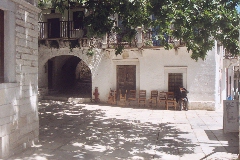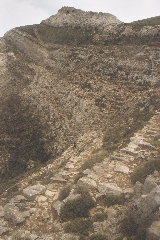Apíranthos - Fanári - Moní |
||
|
Evaluation:
This hike starts in the beautiful village of Apíranthos, it goes to the
summit of the Fanári and it continues through an impressive landscape to
Moní. Because of the marvellous panoramic view from this 883-metres-high
top and because of the wonderful rock landscapes, this hike deserves an
evaluation of ***. Some stretches in the second half are difficult to
follow.
Estimated time: It takes about 40 minutes to hike to the top of the Fanári-mountain and
then 1h45 to Moní. This makes for 2h25 of actual hiking time (AWT), for
a total length of 5,74 km, which proves
that we didn’t make good progress on some points. I reality, you should
devote about 5-6 hours (TWT) to this hike – we walked from 10am to 4pm.
Usually, there are no buses in Moní. You can perhaps continue to Chalkí,
where you can take the bus or a taxi.
Route description: [Do not get off at the first bus stops in
Apíranthos, but wait until the bus reaches the furthest part of the
village, after having described a large bend. On the left you will see
the church Kímissis tis Theotókou and on your right-hand side there is a
large war monument. From this bus stop you enter the village, where you
can first wander around for about one hour.]
[You first get to a rectangular square with the shop of "The Aperinthian
women’s association" (where they sell all kinds of different textile),
with some fancy bars and with the workshop "Apiranthos Art". The square
leads to a beautiful street, paved with marble tiles: to the left there
is the café Samarádiko with a great outdoor terrace; you also pass the
tiny little church of Agios Sardónis. A little further down you get to
the archaeological museum that was established by Michaïl Bardáni: to be
seen in this museum are a lot of small Cycladic statues, a clay vase
from the 3rd millennium BC, a geometric tripodos from the 8th
century, some prehistoric stone tools, bronze arrowheads, etc.
The platía of Apíranthos.
You then reach a small platía with beautiful houses from 1846 and 1897.
Above these houses you find the folk museum, consisting of three rooms
of a not too old house: in the living room, the kitchen and the bedroom
you can see all kinds of traditional objects and tools. If you want to,
you can then continue to walk in the street for a little while,
whereupon you should return to your point of departure. If you follow
the asphalt road further to the left for a short while, you can also pop
into the museums of natural sciences and geology.] (0h00) You begin this walk on the square, opposite the church of Kímissi tis Theotókou (so to the right, if you come from the asphalt road), and you take the marble staircase (hiking sign Fanári 30' / Moní 1h50 + [8]).
The marble staircase in Apíranthos, where the hike [8] begins.
After 42 steps you go RIGHT - with a kamára (or archway) on the left
side - and then you take a left (2 X red mark). After a flat stretch,
you turn left, right and left again, and then you go up again on steps
(red dot). After another flat stretch, you go up again and take a left
until you reach a small concrete road.
Above Apíranthos, the little church of Agia Paraskeví.
You follow across another small concrete road [8], which rises to the
right of the ruins of a mill; the road turns right until you
pass a large cistern after some 200 metres.
(0h10)
At this point a path starts sharply to the left (hiking sign Fanári /
Moní and [8]).
The hiking sign for the walks [8], high above Apíranthos. [[The
other branch of walk [8] continues to follow the little road - see the
hike Apíranthos - Sífones - Stavrós - Keramotí.] You thus take a sharp left, but a little later, you go right through a breach in a wall and you pass through a gate in reinforcing steel (red dot). Later, the trail winds and describes 4 times turns right and left. The retaining walls of the monopáti are still clearly visible, but also the red dots are convenient, as the trail is rather vague in the beginning. The path goes up fairly steeply and behind you, you can see that Apíranthos is quite extensive – it also appears to consist of two parts. Beyond the village, towards the south east, you have a great view on the island of Donoússa (on the far left), the island of Amorgós and behind the hill the other small islands or “eremonisiá” (the little islands between Náxos and Amorgós).
Panoramic view over Apíranthos. (0h18)
After climbing up steeply for about six minutes you go through another
breach in a wall; the trail then continues in between walls, but it is
very stony and quite steep. You then walk again on a marvellous stone
monopáti, that climbs gently on the almost white slope of the Fanári -
further, there are also beautiful steps, then you come again between
quite abundant vegetation (two cairns).
The path to the Fanári.
The summit of the Fanári.
(0h28)
Ten minutes after the breach, you get to a clear junction: a red arrow
directs you to the right sharply, at an altitude of 750 metres.
Further on you arrive at a gravel road, which you
follow to the right.
Three-four minutes later though, you arrive at windy
pass between the top of the Fanári and a lower summit on your right.
[If you miss the bifurcation, you simply can continue straight on,
because you will arrive anyway at the gravel road, where you should take
a right of course. |
(0h33)
You take the path that goes up to the left towards the wall and the
chapel on the top of the Fanári.
This is a beautiful climb,
the last minutes on a staircase with 70 heavy steps.
On the right, on the lowest summit, you find
the small church, with a picnic table; the left-hand top is another ten
metres higher.
(0h41)
Over here you have a great panoramic view: in the Tragéa-valley you can
see the villages of Damariónas, Damalás, Chalkí and Moní, to the right.
Beyond you can discern the bay of Náxos, with also the islands of Páros,
Syros, Tinos and Mykonos. On the other side there is the bay of Mutsúna,
with beyond the islands of Donoússa, Amorgós and Koufoníssi all the way
to the right.
On top of the Fanári. (0h41) It takes about ten minutes to descend to the gravel road, which you follow to the right. You continue on this road for a little under ten minutes. After two minutes you pass the trail, which, just now, you followed on the way up. This time you go straight though, since the path going down will also get to this gravel road later on. You thus reach a windy pass again, where the view on the valley in front of you is great, with to the right Moní, your destination. You continue to go down on the gravel road, in the direction of a rocky hill, with two large pastures, some walls and stables – at the bottom you can clearly distinguish the staircase-trail. (1h00) After altogether ten minutes on the gravel road you take a path going to the right, next to the wall and in a bend – there is also a cairn, the village of Filóti seems really nearby... You follow this trail which descends to the right between little bushes [8]. Soon, you get to the RIGHT of a circular wall (red arrow): you meander a little through the vegetation, but then you should clamber on pale rocks next to the big wall and in this way you automatically arrive at a very clear path that continues to the right.
(1h04)
You now begin a wonderful descent, on a meandering rocky trail and
amidst an impressive landscape. On the right you see the steep cliff of
the Fanári, in front of you there is the marvellous valley with the
villages of Moní and Chalkí (invisible on the left). At first the
landscape is very rocky, and you follow two stretches of a trail with a
nice pavement and marvellous turns – first there are 8 sharp turns and
after an almost flat stretch, you follow again 11-12 steep, stony bends.
The monopáti that meanders downhill from the Fanári-mountain.
(1h22)
After 18 wonderful minutes, the path becomes more narrow, and the
following part is difficult: you indeed should descend to the RIGHT on
the steep slope, where you can only distinguish the remains of the
retaining wall - the path has disappeared because of a landslide. After
5 difficult minutes, you get against a wall, on a side path. You take a
right for a short while and you then go left (red arrow) in between the
walls. The vague path meanders between the walls;
halfway there is a shady spot, where it is pleasant to have a picnic.
(1h33)
You climb to the right on
rocky ground (red arrow and [8]) and, at the top, you can finally follow
a good path to the left between walls (red arrow and mark).
Further on, the path is dug
in and shaded (red mark).
You then follow a pleasant dirt path which
continues between a fence and rocks and which describes, high above the
valley with olive trees, a large bend to the left.
At the end of the terraces,
you go up to the right on a vague terrain with rocks and low walls (red
marks);
at the top, the path
becomes clearer, it continues along a fence.
Panoramic view on Moní.
(1h57) The continuation is again much steeper, you still go
through a gate and you cross a small concrete bridge.
From this square there is a small street in the right angle, which
brings you to the centre of Moní. After 50 metres, at the end of the
street, you can have another beautiful view on the valley towards the
left – all the way to the left you can even see the Fanári, with Filóti
and Damariónas. Gpx-files: https://www.wikiloc.com/hiking-trails/naxos-apiranthos-fanari-moni-93156110 https://www.routeyou.com/en/route/view/10162041/hiking-route/naxos-apiranthos-fanari-moni To
get the printer-friendly version |
|












